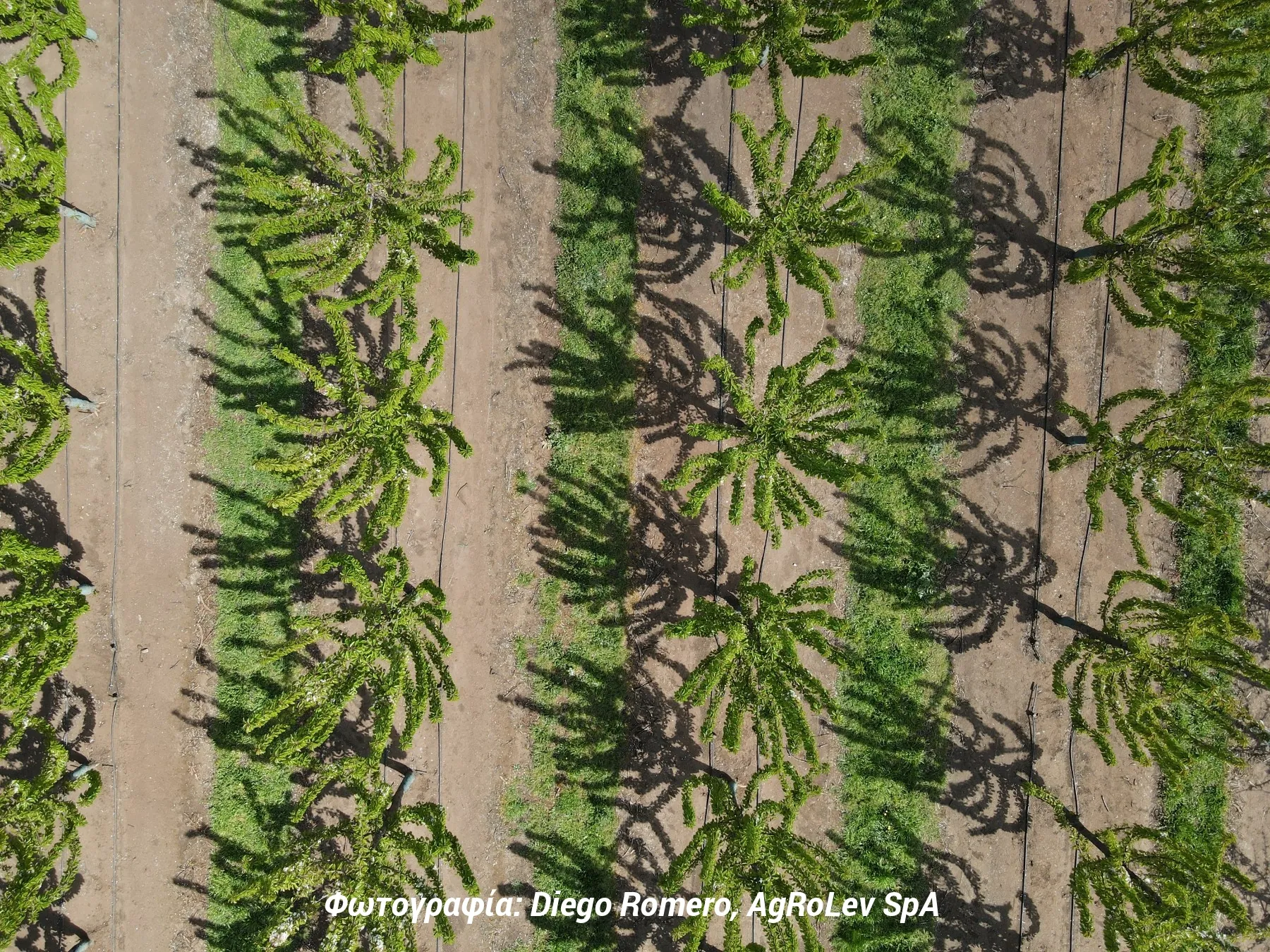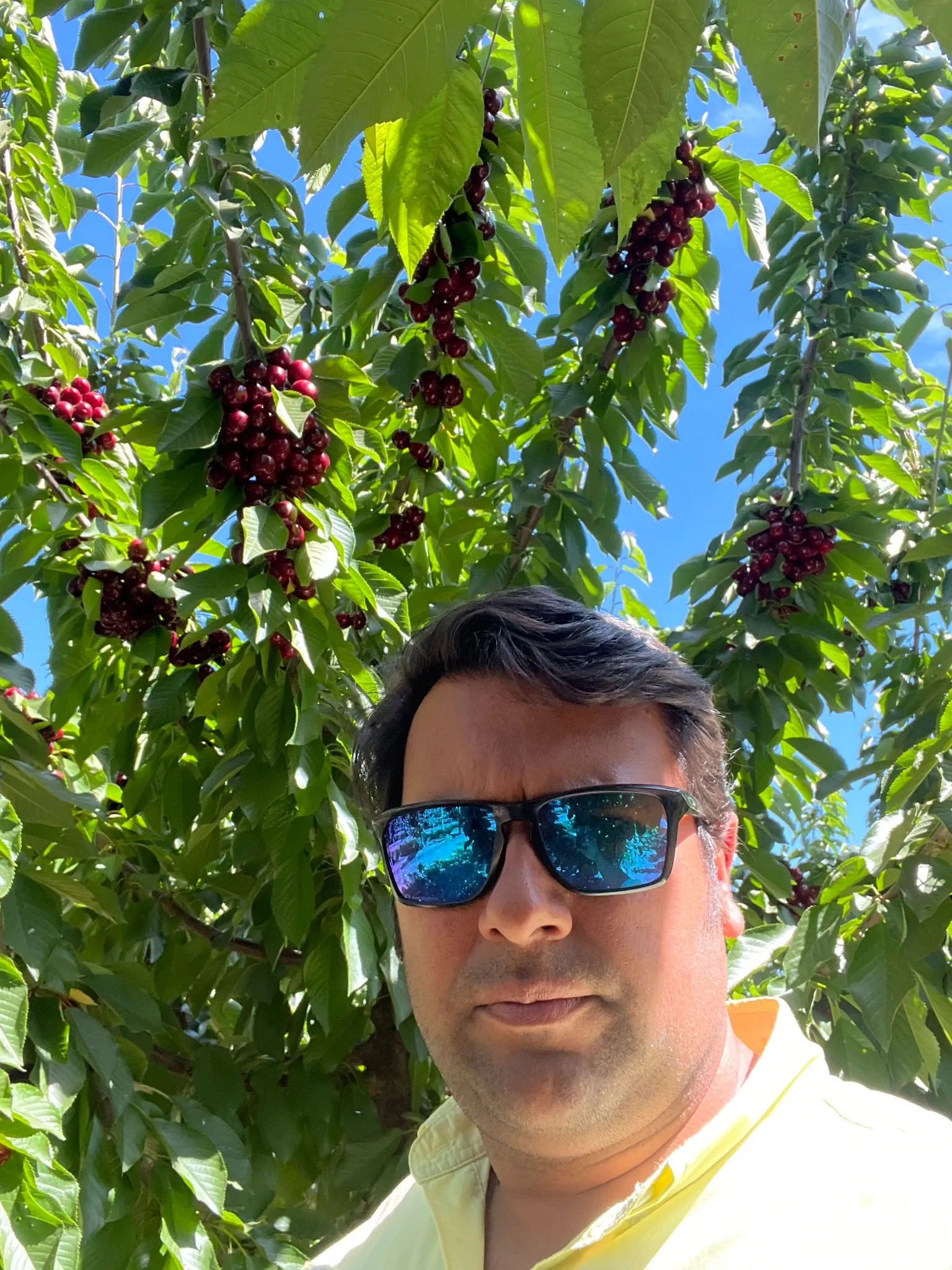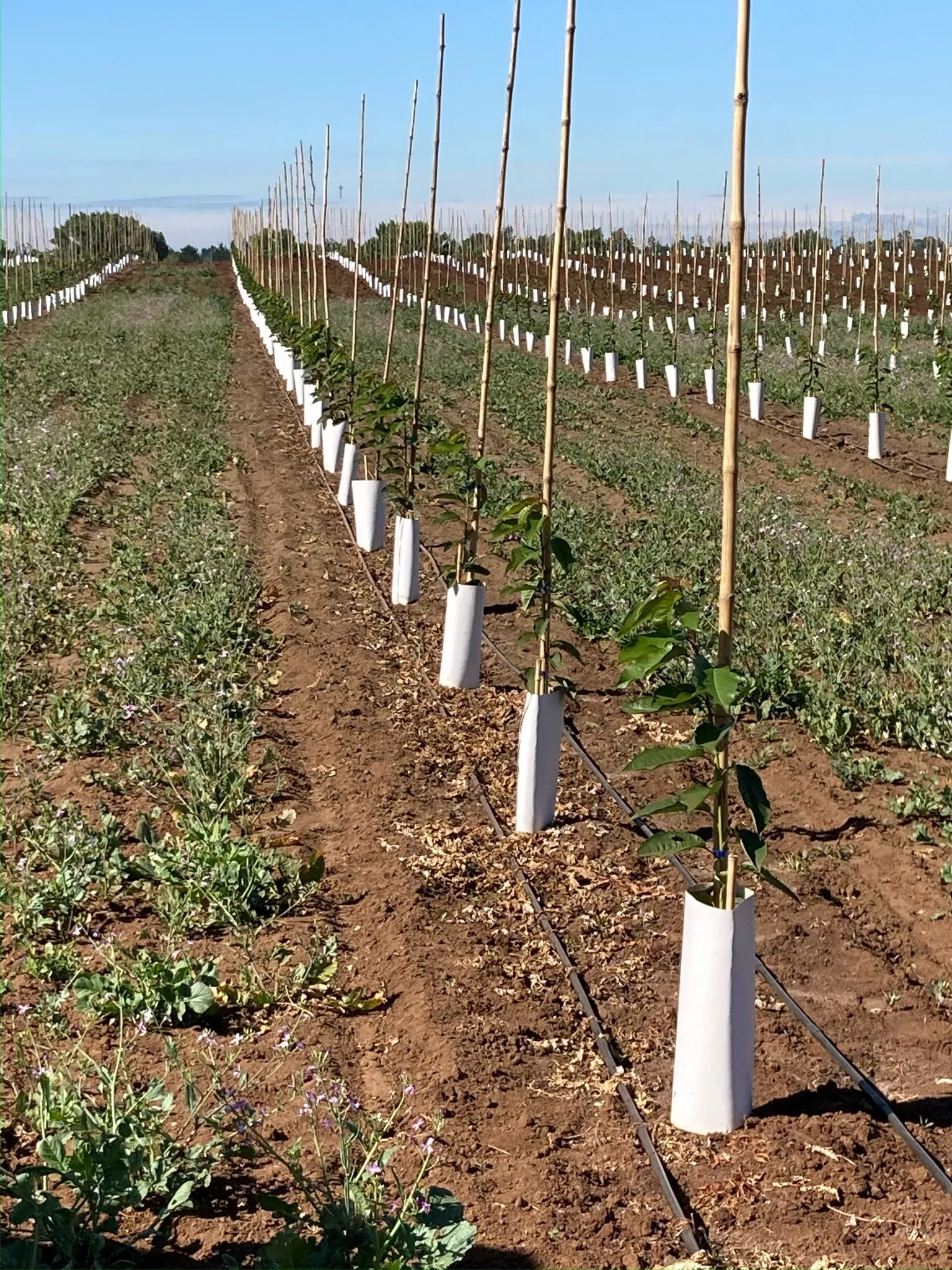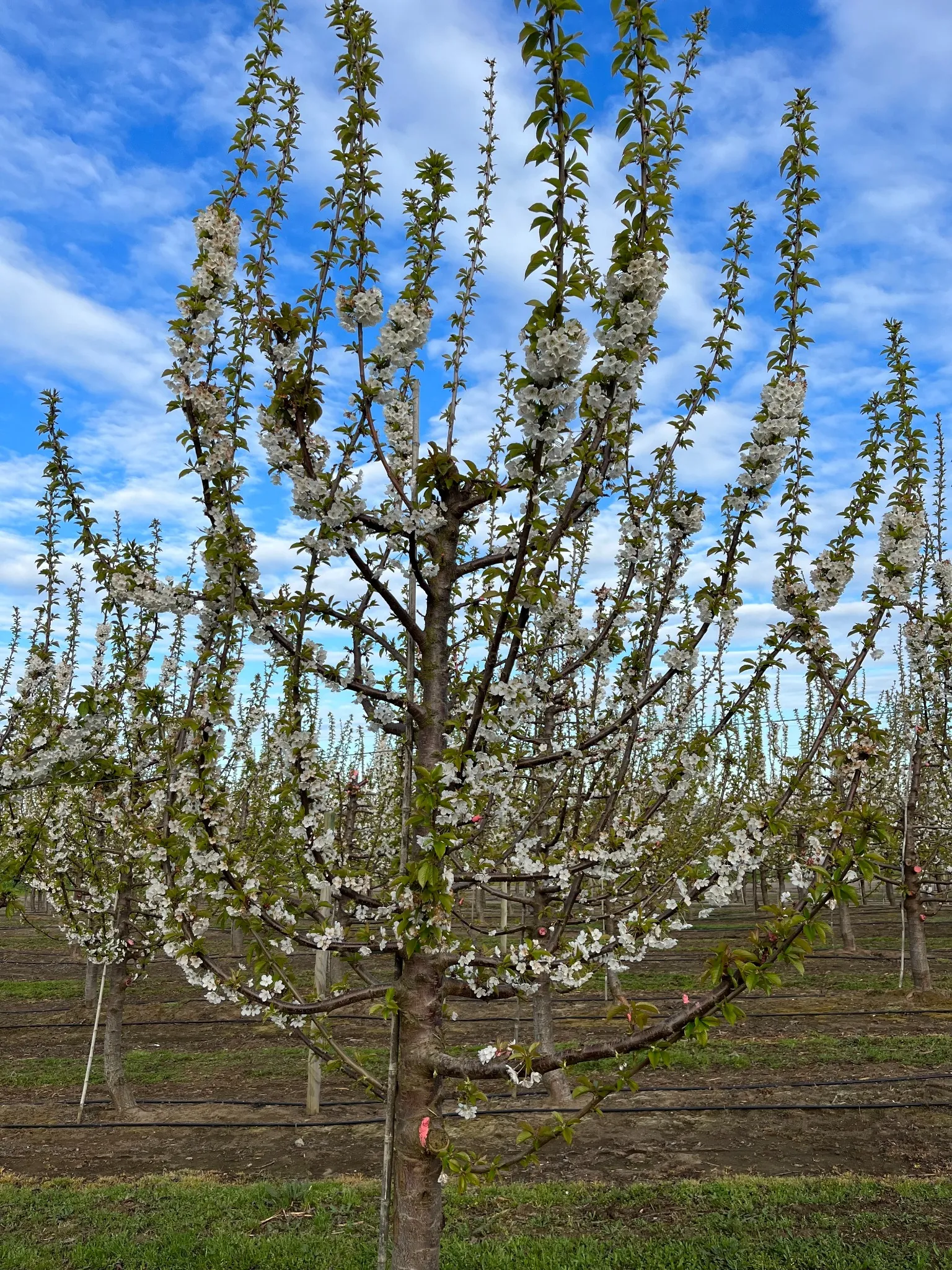
The issue of labor shortages in agriculture, as well as the high cost of wages, affects not only Greece but also most developed agricultural countries worldwide.
This is a major reason to seek cultivation systems that help mitigate this issue without compromising fruit yield or quality.
In Chile—one of the most advanced countries in terms of cherry marketing and ongoing research and cultivation improvement—a new system has emerged that can be considered a philosophy of agricultural investment management. This method, promoted by Chilean agronomist Diego Romero Iragüen, is aptly named K.I.S.S. (Keep It Super Simple) (Photo 1).
 Photo 1. Chilean agronomist Diego Romero Iragüen
Photo 1. Chilean agronomist Diego Romero Iragüen
The KISS philosophy is not limited to cherries—it can be applied to other crops as well. It was first tested on cherry cultivation due to long-term observation of cherry tree growth physiology and the difficulties encountered with complex training systems, including expensive and time-consuming pruning and trellising practices.
The system is not yet widespread in Chile, but its prospects for adoption are promising, as an increasing number of cherry growers are adopting its principles. Many new orchards are now being planted with the goal of following this approach, driven by the rising costs and scarcity of labor.
The main objective of the KISS system is to perform basic cultivation and tree pruning in the simplest and most cost-effective way, as its name suggests. The goals include reducing tree training and pruning labor, improving canopy light penetration and air circulation, and ensuring large fruit size, since most fruit is produced on primary scaffold branches.
A single-trunk configuration is recommended for cherry trees, using vigorous to moderately vigorous rootstocks (e.g., Maxma 14, Piku 1, Gisela 17, PHL-C, Colt, etc.) to avoid the need for costly trellis systems with posts and wires (and associated tying labor).
If a pre-existing trellis system is already in place from a previous orchard, it does not need to be dismantled—the system can still be implemented.
The recommended planting distances are 2.5–3 m between trees and 4–4.5 m between rows, resulting in a density of 750–1000 trees per hectare, which is considered relatively high (more than 800 trees/ha is dense).
There are no restrictions regarding the choice of varieties. These are selected based on producer criteria such as maturity timing, fruit quality traits, resistance to cracking and diseases, and market potential.
Target yields after the fourth or fifth year are 15 tons/ha, with 90% large-sized fruits (28 mm or more) of uniform color. At full maturity, yields can reach up to 20 tons/ha with consistent quality.
Planting is carried out at the specified distances during the entire dormancy period, from December to February.
For optimal growth results, early planting is recommended, ideally from December to mid-January.
Young trees are not pruned at this stage because they have not yet reached their final height. To ensure uninterrupted vertical growth, trees should be staked (e.g., tied to bamboo canes), especially in windy regions (Photo 2).
From spring onwards, plant protection treatments begin to prevent pest and disease attacks, along with weed control operations (always spray at low pressure to avoid damaging sensitive young plants).
 Photo 2. Young cherry tree managed using the KISS system (D. Romero)
Photo 2. Young cherry tree managed using the KISS system (D. Romero)
During the bud swell stage (in March, depending on the year), incision treatments are applied using “promalin” formulations to stimulate the formation of around 25 lateral shoots evenly along the trunk in all directions.
The developed shoots (Photo 3) must be trained to develop at wide angles from the main axis, which is particularly important for orthotropic varieties.
This can be achieved using traditional methods (tying, weighting, etc.). However, to reduce costs and labor, the KISS system suggests inserting toothpicks at the base of the shoots once they reach 20–25 cm in length, before lignification occurs (Photo 4).
 Photo 3. Developed shoots on a two-year-old cherry tree (D. Romero)
Photo 3. Developed shoots on a two-year-old cherry tree (D. Romero)
 Photo 4. Use of a toothpick to widen the shoot angle (D. Romero)
Photo 4. Use of a toothpick to widen the shoot angle (D. Romero)
At the end of the second growing season, the final tree height can be defined by stopping the vertical leader at a height that facilitates harvesting but does not sacrifice productive area. An indicative height of 2.3–2.5 m is suggested.
At this stage, shoots should not exceed 90 cm in length. Fertilization rates are adjusted accordingly (reduced if shoot growth is excessive, increased if growth is weak). Upright shoots with narrow angles are shortened for easier future management.
In spring of the third year, flowering begins—especially when using vigorous rootstocks. Close attention should be paid to fruiting organ emergence, which helps guide fertilization, irrigation, and, if needed, growth regulator applications.
If tree vigor and development are satisfactory, no additional interventions are required.
During winter pruning, overly vigorous branches are removed to maintain balanced growth. These branches are cut back to about 12 cm to stimulate new useful shoots in subsequent years (Photo 5).
Branches that shade or crowd others are also removed.
 Photo 5. Pruning of a vigorous branch to encourage new shoot development (D. Romero)
Photo 5. Pruning of a vigorous branch to encourage new shoot development (D. Romero)
By year four, the orchard appears like a hedge along the row, entering an almost full productive phase, especially with vigorous rootstocks (Photo 6). Fruit has uniform color and is mostly larger than 28 mm.
 Photo 6. Productive K.I.S.S. orchard in full fruiting (D. Romero)
Photo 6. Productive K.I.S.S. orchard in full fruiting (D. Romero)  Photo 7. Flowering cherry tree trained under K.I.S.S. principles (D. Romero)
Photo 7. Flowering cherry tree trained under K.I.S.S. principles (D. Romero)
Efforts to improve cherry cultivation continue to engage the agricultural sector. Although it is generally a profitable crop, it presents specific challenges such as harvest labor, pruning, and maintaining tree productivity.
The KISS management philosophy offers solutions in the face of recent trends such as labor shortages, rising cultivation costs, and increasing fruit quality demands. It simplifies orchard training and pruning practices while preserving high fruit production potential through sustainable planning.
With larger orchards and reduced access to skilled pruning labor, maintaining farm efficiency is key.
The KISS system promotes "Simplicity"—as the name implies—in shaping and pruning operations, improving light and air flow in the canopy, which translates into better fruit quality.
Another task made easier by KISS—commonly practiced in Chile but not in Greece—is the thinning of flowers or fruiting organs to improve fruit size.
Additionally, a key sustainable aspect of KISS is the precisely defined renewal of 3–5 fruiting branches per year, a concept reminiscent of the “Spindle” tree architecture, and somewhat comparable to the KGB system, although the latter falls under “low cup” systems.
The Department of Deciduous Fruit at Naoussa, part of the Hellenic Agricultural Organization - DIMITRA, should present this system to the farming community as an alternative approach worth exploring.
We extend our sincere thanks to our Chilean partner, Diego Romero Iragüen, without whom this article would not have been possible.
Konstantinos Kazantzis1, Diego Romero Iragüen2
1 Hellenic Agricultural Organization - DIMITRA, Institute of Plant Breeding and Genetic Resources,
Department of Deciduous Fruit in Naoussa, Greece
2 AgRoLev SpA, Technical Horticultural Consultancy, Los Angeles, USA